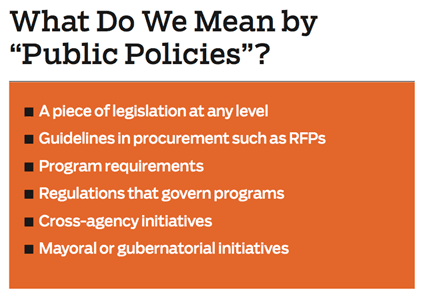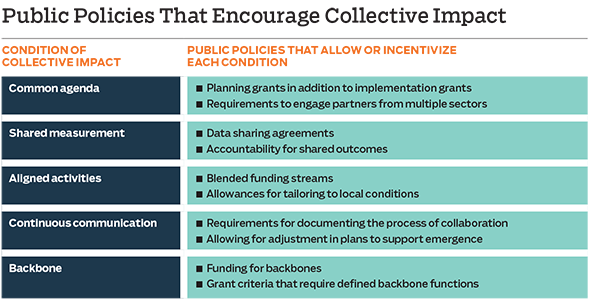SPONSORED SUPPLEMENT TO SSIR PRODUCED FOR THE COLLECTIVE IMPACT FORUM
Collective Insights on Collective Impact

This special supplement features the most recent thinking and learning about how to use the collective impact approach to address large-scale social and environmental problems.
-
Essential Mindset Shifts for Collective Impact
-
Defining Quality Collective Impact
-
The Role of Grantmakers in Collective Impact
-
Power Dynamics in Collective Impact
-
Roundtable on Community Engagement and Collective Impact
-
Aligning Collective Impact Initiatives
-
Learning in Action: Evaluating Collective Impact
-
Achieving Collective Impact for Opportunity Youth
-
Making Public Policy Collective Impact Friendly
Cross-sector partnerships across the country are working hard to achieve collective impact. Although public policymakers often share the goals of these partnerships, federal, state, and local policies too often impede rather than enhance the conditions necessary to operate collectively. Worse, some public policies explicitly prohibit the very things that collaborative partnerships need to succeed. Rigid funding models, a narrow focus on annual reporting, silos within and between agencies administering programs and funds, and inaccessible or unaligned data sets all create obstacles to achieving collective results.

One of the reasons this problem exists is that the structure of government often works against collective solutions. Policymakers typically operate within isolated sub-committees, departments, and agencies that result in loyalty to a specific issue and funding stream. But not all problems lend themselves to a narrow, targeted response. Many are better addressed through simultaneous action by more than one office. In these cases, siloed governmental structures and processes are counterproductive. Moreover, policymakers and partnerships often lack clear information about what types of collaborative actions are even allowed.
It comes as little surprise that when governmental culture and auditing practices inhibit risk-taking, public policies that promote collective impact are few and far between. Nonetheless, some current policies, governmental structures, and processes do help partnerships achieve collective impact. (See “What Do We Mean by “Public Policies”? at left.)
A Step in the Right Direction

Some public policies explicitly allow and incentivize partnerships to create each of the five conditions necessary to achieve collective impact. (See “Public Policies That Encourage Collective Impact” below.) These public policies are found in issues as diverse as youth development, economic revitalization, and health, as shown by the following three examples.
Performance Partnership Pilots, managed collaboratively by several federal departments, provide selected communities with needed flexibility to use existing federal funds to create a coordinated approach to disconnected youth (low-income young people between the ages of 16 and 24 who are not in school and not employed).1 Providing the variety of services they need—including education, job training, health care, childcare, food assistance, and housing—through multiple independent programs proves inefficient and ineffective. The Performance Partnership Pilots will allow communities to bring these disparate programs together to create a more unified solution. In return, each partnership must use a rigorous accountability system to monitor their results and correct course as needed.
The Working Cities Challenge, funded by the US Federal Reserve Bank of Boston, incentivizes collaborative leadership to promote economic revitalization in small cities in Massachusetts.2 It grew from a shared vision of success among leaders from private, philanthropic, nonprofit, and government sectors to develop a new model for investment. Rather than finance single projects, the Working Cities Challenge requires cities to assemble cross-sectoral teams to improve the lives of low-income residents. It provides funding, technical assistance, and peer learning opportunities among grantees.
The Essentials for Childhood program, funded by the US Centers for Disease Control and Prevention, aims to create safe, stable, nurturing environments for children.3 The program explicitly requires a backbone infrastructure, multi-sector partnerships, continuous improvement, and shared outcome measures. Grantees must emphasize their work with partners who may not have worked together in the past but whose work aligns with the overall goals and strategies of a common agenda.
These examples are nascent, so it is too soon to know if they will ultimately lead to positive population-level outcomes. But each example suggests a path forward for policymakers looking for ways to allow and incentivize partnerships to achieve collective impact.
How to Enhance Public Policy
Some public policies explicitly allow and incentivize partnerships to create each of the five conditions necessary to achieve collective impact.
The three previous examples, although promising, remain the exception rather than the rule. Broader adoption of public policies that encourage collaboration will require changes to government structures, accountability mechanisms, and auditing and accounting practices. Below are three approaches that policymakers can take to make government more friendly to collective impact initiatives.
Creating interagency structures focused on populations and issues | The most direct solution to the problem of fragmentation among departments is to create structures that cut across silos. For example, a growing number of states and localities have created “Children’s Cabinets” through which the heads of related departments work toward shared goals on issues from early childhood education to disconnected youth programs.4 These permanent structures are more efficient than ad-hoc interagency groups because policymakers can use their existing relationships and collaborative work processes to confront new problems as they arise and to create a culture of working together that can permeate other parts of government.
Flipping accountability from “services provided” to “outcomes achieved” | Another way to cut across government silos is to hold grantees accountable for results instead of for specific services provided. Pay for Success initiatives, which guarantee funding for organizations that achieve specific outcomes for a population, are a prominent example of outcome-based policymaking.5 By allowing communities to replace overlapping, underfunded sets of services with aligned, efficient, and effective ones, these initiatives are sparking innovative, collaborative projects, many of which may well achieve collective impact.
Changing government auditing and accounting practices | Fear of triggering a governmental audit is perhaps the primary reason that grantees often assume they are not allowed to align, blend, and braid siloed funding streams across agency lines. Fortunately, it is possible to make government more collective impact friendly by changing auditing and accounting rules. For example, the White House Office of Management and Budget recently released a new rule allowing private organizations that receive money from more than one agency to consolidate their reporting.6 Such regulatory changes can permit governments to fund partnerships more successfully.
Conclusion
Although our focus in this article was on public policies, it is important to note that policymakers can also support collective impact directly. In addition to creating and implementing public policies that make it easier to undertake collective impact initiatives, they can, for example, use their bully pulpit to call for effective collaboration, chair collective impact steering committees, share governmental data, and lend their expertise and creditability by participating in meetings or working groups.
All such roles are vital. If policymakers devote their time and energy to helping collective impact initiatives succeed, and if government policies, structures, and mindsets shift to help partnerships create the five conditions necessary to achieve collective impact, we may finally be able to make progress on some of the most important, persistent, and intractable issues facing society today.
Support SSIR’s coverage of cross-sector solutions to global challenges.
Help us further the reach of innovative ideas. Donate today.
Read more stories by Thaddeus Ferber & Erin White.

